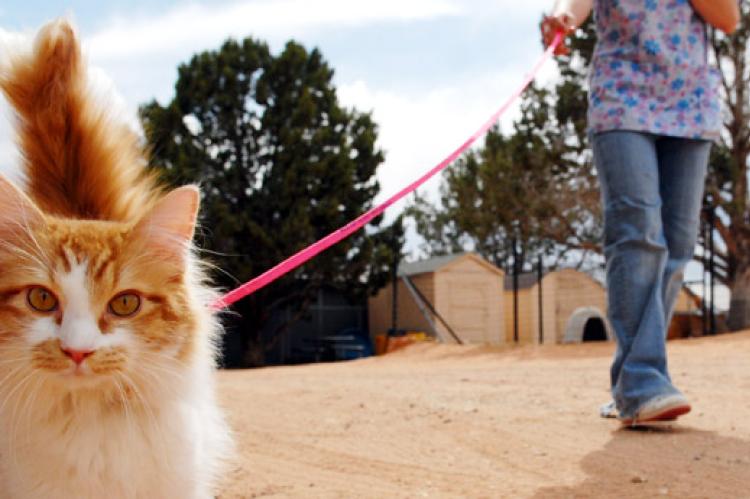How to Walk a Cat on Leash

Walking a cat on a leash: All the cool cats are doing it. Why should you walk your cat? Cats are curious creatures, and any opportunities they have to explore the world can enrich their lives. To help your indoor cat have safe outdoor adventures, you can teach them to wear a cat harness and walk on leash.
At Best Friends, our caregivers have found that walking outdoors lowers stress for many cats, making them happier and healthier. Keep in mind, though, that your cat should enjoy this activity, and all cats are different. If there is any indication that your cat is stressed by wearing a harness or being leashed up, this type of enrichment might not be suitable for them.
Selecting a cat harness
First, you’ll need to buy a cat harness and cat leash. There are many different types of harnesses for cats available online and at pet supply stores that are both functional and stylish.
Choose one that is simple and fast to put on, but make sure your cat won't be able to wiggle out of it. A good harness will be soft, lightweight, and made with high-quality materials.
There are styles with wide Velcro closures, as well as harnesses with buckles. If you only want to deal with one closure, harnesses with a figure-eight configuration and just one buckle can be a good option.
Teaching your cat to wear a harness
Next, you’ll want to get the cat accustomed to the harness. Leave the harness in your cat’s sleeping area for a few days, so they can inspect it. Then, determine the steps necessary to put your specific harness on the cat. Some of the steps might include:
- Slide the harness over their head.
- Rest the harness on the back of their neck.
- Adjust the belly straps.
- Fasten the closures.
Reward your cat with treats after you perform each step, taking care to notice whether they’re showing signs of anxiety. Speak in a friendly voice, and tell your cat that this is the beginning of a big adventure.
If the cat gets too anxious, take the harness off and try again the next day. It will likely take several sessions for your cat to get comfortable with the harness. If the cat isn’t making progress, try consulting a behavior professional, or look at alternatives, such as a cat stroller.
How to walk a cat
Once your cat is comfortable wearing the harness, clip on the leash and let your cat walk around indoors. Again, use treats and a soothing voice to make it a positive experience. During this indoor trial run, make sure you adjust the harness properly to fit your cat; you don’t want it to be too tight or so loose that they can slip out of it.
If your cat seems relaxed with indoor walks on leash, try it outdoors. For your cat’s first time outdoors, carry them outside (while wearing the harness and leashed up) and set them down in a safe and quiet place, such as a fenced backyard. Make sure to leave the door open, so they can retreat inside if they get scared.
While your cat is on leash, let them go wherever they want, though keep them well away from traffic and other hazards. Always keep the leash slack; don’t ever pull on it. If your cat is startled by a noise or something else in the environment, try to keep the leash slack until you can reach them to prevent the cat from wriggling out of the harness. Until your cat is comfortable with being outside and is used to the sounds and sights, we recommend bringing along a towel to protect yourself should the cat become distressed and need to be picked up and carried back inside.
Before long, though, your cat will probably look forward to walks. Many of the cats at Best Friends who started out timidly are now pros, and outdoor excursions are an exciting part of their day.